Cleopatra bath - a divine procedure in your home
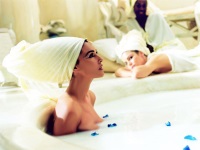
Milk bath is a useful and very simple procedure, which is associated with the beauty Cleopatra. And although there is no absolute certainty that the real recipe of the ancient queen's bath of youth has come down to us, it is worth trying the action of Cleopatra's bath with the addition of milk.
Benefits
A bath with milk affects various body systems, but its greatest effect is on the circulatory system and the skin:
- In a milk bath, blood circulation is stimulated,
- The skin cells are enriched with minerals and nutrients.
- all this leads to the stimulation of metabolic processes, including fat metabolism (for this reason the milk bath is often used for weight loss).
- vitamins and other beneficial substances from milk during the water procedure get into the skin, refreshing and tightening it. The result will also smooth fine lines, increase elasticity and moisturize the skin.
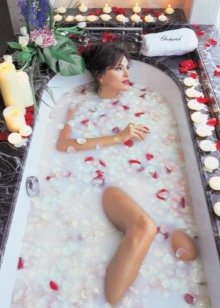
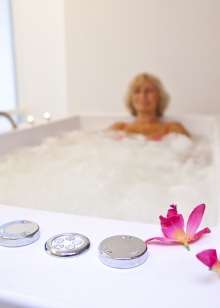
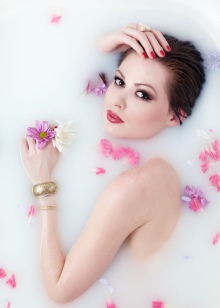
When honey is added to the water, its proteins and fats also moisturize the skin, preserving the effect of the procedure for a long time.
Milk has a healing effect on the hair, especially weakened by vitamin deficiency, seasonal changes and negative natural factors.
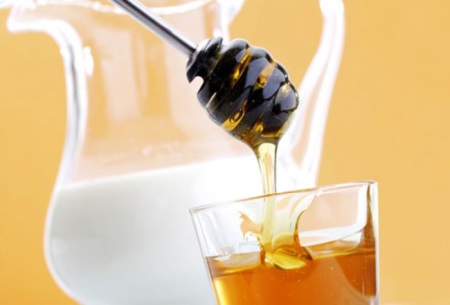
Such a bath is simply indispensable as a support for skin tone during diets, to relieve soreness after workouts, as well as to get rid of cellulite and swellings. In addition, such a pleasant bath has a psychological effect.
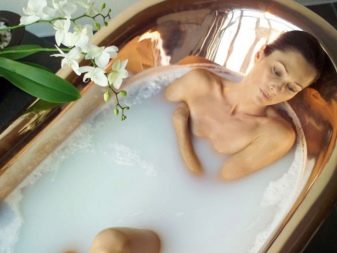
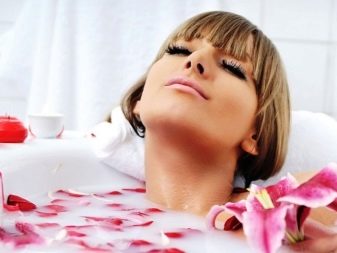
Harm
Negative effects of such a bath threaten people with allergies to its components, as well as with damage to the skin.
Contraindications
Although the procedure, at first glance, is very easy, but for its implementation there are nuances and precautions.
Immerse yourself in a milk bath should be at least 2 hours after meals. If you have vascular or heart disease, the procedure should be short (maximum 15 minutes), and the water in the bath should not cover the heart area.
If your skin is damaged or irritated, the milk bath sessions should be postponed, or honey should not be added to the water so as not to exacerbate the negative manifestations. Such water procedures are also not recommended for inflammation of the kidneys and genitals. You should not experiment with the milk and honey bath and pregnant women.
Video
Watch the following video about Cleopatra bath, take ideas for creating a relaxing atmosphere and bliss.
You can see what the procedure looks like in a specialized salon in the following video. Beautiful, isn't it?
The choice of milk
Cleopatra for her milk baths, it is said, used donkey milk (according to another version - the milk of a camel).
Today's beauties find it difficult to get, but that's okay. Any other milk will do for the healing procedure. More often cows milk is used for this bath due to its high availability. The milk should be chosen quite fatty. It is also good if you use a non-pasteurized drink, because in this case the effect of the bath will be more intense.
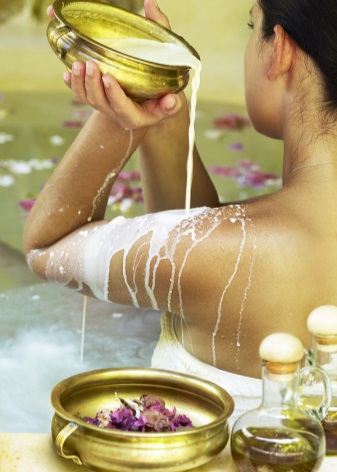

One of the best options is goat milk, which has a pH close to that of human skin.
Oat milk perfectly soothes and moisturizes the skin due to the presence of oat particles in it. Baths with oat milk are especially useful for those with problematic or sensitive skin. Soy milk and rice milk are also noted to have beneficial effects on the skin. Not a bad reputation and proved itself and the bath, which is added not milk, and whey milk.
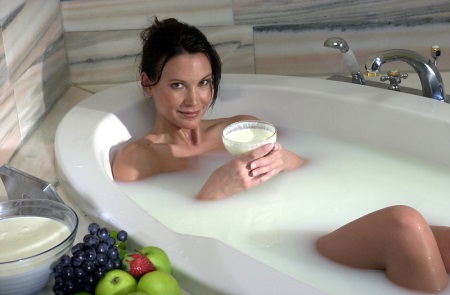
Rules
Prepare a milk bath at home is very easy, because the ingredients are available. For one bath, a liter of milk is enough, and to be more effective, two or three spoons of honey are added to it. First, water is poured into a container, and then slightly heated milk and honey are poured into it.
You should take a bath with milk for an average of 15 minutes, and if there are no contraindications and your well-being is normal, then the session can be increased to 30 minutes. Immerse yourself in water so that your breasts remain above water.
Take treatments 1-2 days apart or at least twice a week. The optimal temperature for this procedure is 36-38 degrees Celsius. Do not exceed the temperature of +38 degrees, so that the useful substances in the milk and honey are not destroyed.
At the end of the procedure you may not take a shower, but if you feel discomfort (this can happen with too much added honey), rinse with cool water and lubricate your skin with light moisturizing cream or natural oil. If there is no discomfort, it is better not to wash off the honey-milk film from the skin.
The only procedure that is allowed after the Cleopatra bath is a honey massage. Use the same kind of honey that you added to the water. After the session, drink herbal tea and rest, or better yet, go to sleep.
Ways to Improve the Procedure
Cleopatra is rumored to have enhanced the effect of her milk and honey bath by adding almond oil to it. Mix 5 drops of this aroma oil with 3 tablespoons of sea salt and add to the water.
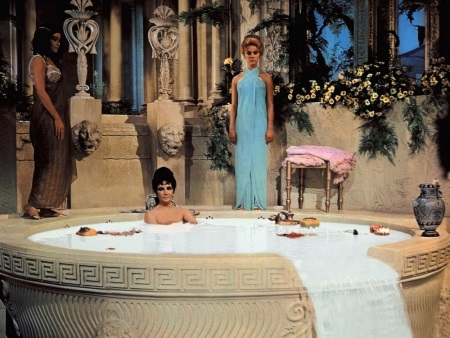
Other options to improve the procedure would be:
- Combining the bath with a day of unloading (if you are doing a milk bath for weight loss);
- adding cinnamon oil to the water (you can also throw a cinnamon stick in the bath);
- adding seaweed or coconut milk;
- combination of milk bath with herbal (add to the water decoction of chamomile, pine needles, hops, linden blossoms, mint and other medicinal herbs).

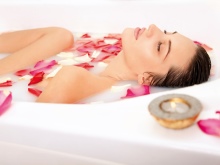

To milk bath was effective in the fight against stretch marks, and its beneficial substances penetrate deeper into the skin, before the procedure, we recommend a peeling. For this, mix coffee grounds with orange oil and also with cream. The cream can be replaced with yogurt or sour cream, and the coffee grounds with sea salt.
Note also that to prepare a milk bath against stretch marks, it is worth adding an increased amount of milk - up to 5 liters.
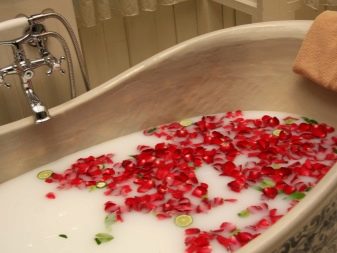
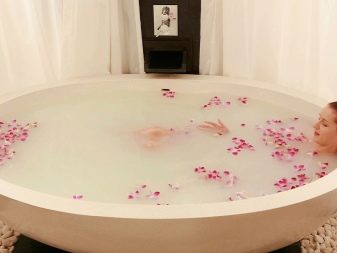
If the Cleopatra bath serves as the basis for a romantic water treatment with your lover, add rose petals to the water, and decorate the room with candles.





This is my favorite bath. I was looking for something else to add to it) I will use almond oil. Dear women, spoil yourself and take a bath like this. We live once, live with pleasure!